On tours of a restored salmon cannery that’s 130 years old, the interpreters dance around a racial slur that the Chinese-Canadian community wants acknowledged but nobody wants to say aloud.
We’re standing at a butchering station and learning how young skilled, mainly Chinese men once cut the heads, tails, fins off four to five salmon a minute, splitting their bellies and removing their guts. Then we step over to a seemingly innocuous red machine that made most of this fast-paced and dangerous work obsolete in 1906 because it could process 60 to 70 salmon a minute.
The brand has been removed but speaks to the overt anti-Asian sentiment of a time when Canada no longer needed Chinese migrants to build its railway. We are reminded that from 1885 to 1923, Chinese immigrants were forced to pay a head tax (first $50 Canadian and eventually $500) to enter the country.

Jamie Lee, head interpreter at Gulf of Georgia Cannery National Historic Site, demonstrates how the "Iron Butcher" worked and replaced human workers/Jennifer Bain
Jamie Lee, head interpreter for the Gulf of Georgia Cannery National Historic Site, says people from the community want them to “share and talk about “this very discriminatory policy.” It’s also by their request “that we do keep the name on, for example, the machine we have on display in our front area because it was a part of what they faced and went through then.”
Nobody prods Lee to reveal the derogatory name out loud. Instead, I walk back to the entrance and look for myself. In front of a vintage photo of men butchering fish, this second machine has an iron plaque bearing its name and the year 1946.
“The butchering machine revolutionized the salmon canning industry by replacing a 30-man Chinese butchering crew with a fast, efficient machine,” interpretive signage explains. “Patented as the `Iron Chink,’ this trade name reflects the racial attitudes of the time.”
Staff call the machine the “Iron Butcher.”

At the request of the local Chinese-Canadian community, a salmon cannery machine marketed using a racial slur is on display at the Gulf of Georgia Cannery National Historic Site so it can speak to racism and discrimination/Jennifer Bain
Built in 1894, the Gulf of Georgia Cannery was once the largest building of its kind around here and the leading producer of canned salmon in British Columbia. It stopped canning in the 1930s but survived as a net loft, fish depot and herring reduction plant. As fish processing was winding down in the late 1970s, heritage-conscious citizens galvanized support for federal recognition as a national historic site.
The cannery — one of B.C.’s few restored canneries — is on the South Arm of the Fraser River along the Strait of Georgia in the city of Richmond. It’s on the traditional ancestral lands of xʷməθkʷəy̓əm (Musqueam) people, in the village of Steveston which was built atop of the Musqueam seasonal village sites known as q’weya?xw (Garry Point) and qwle’yem (Driftwood place).
This is one of Parks Canada’s 171 national historic sites and one of just a few operated by a third party — the non-profit Gulf of Georgia Cannery Society.
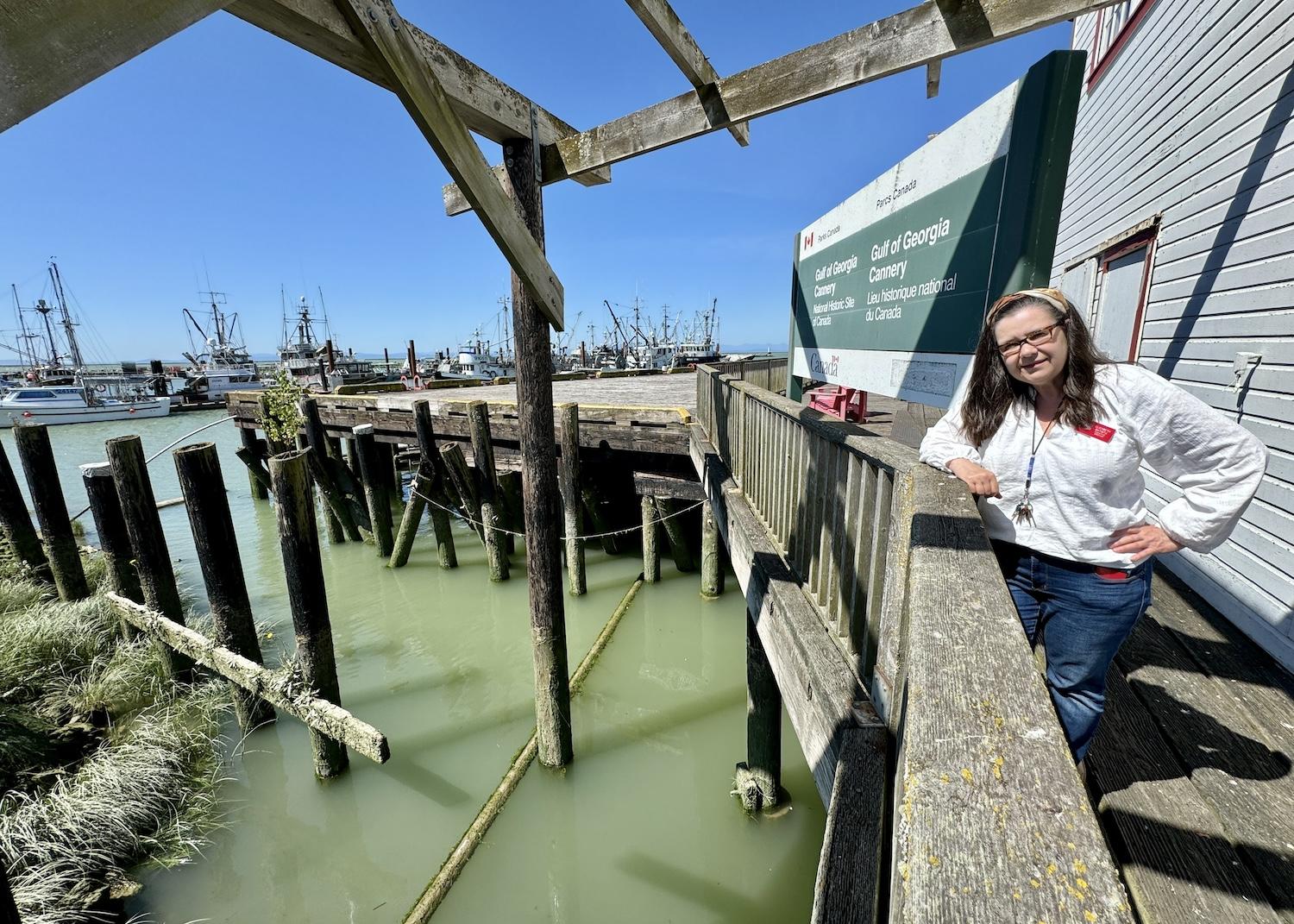
At the Gulf of Georgia Cannery National Historic Site, executive director Elizabeth Batista shows how the building sits atop wooden pilings/Jennifer Bain
“This place is about an authentic experience,” says executive director Elizabeth Batista. “You get transported back in time, but you can look out the window and you can see the same work and the same culture thriving.”
Indeed, the cannery sits on aging wood pilings over the Fraser River by the Salish Sea and Pacific Ocean where salmon were once piled in the receiving dock. You can step outside to see a working fishing harbor. A recording of birds of prey plays on a loop to scare away the gulls that land on the roof.
About 42,000 people visit each year. There’s a fee but I can use my annual Parks Canada Discovery Pass to get in.
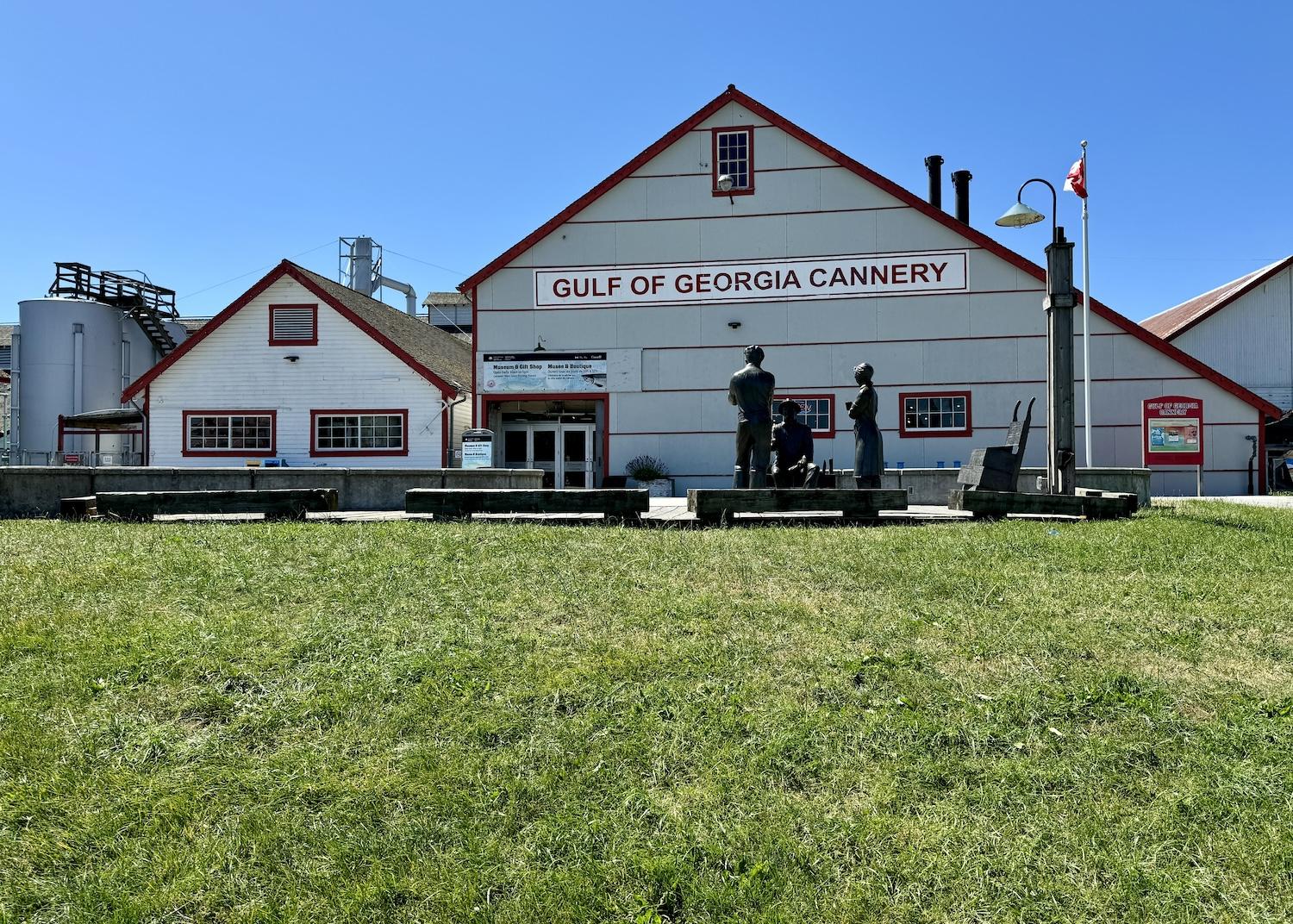
The Gulf of Georgia Cannery was built in 1894 and over the years, other buildings were added to the complex/Jennifer Bain
Batista, who started volunteering here in 2015 before moving up the ranks in 2022, doesn’t see machines anymore — just people. “When I see a machine,” she explains, “I see who would have worked here, for how long and how many people they were supporting.”
She loves meeting “people who either worked here, fished here or had family that worked here that can actually tell us what it was like to work at the cannery. Those are the stories you don’t typically see in a history book. Personally, I learn something new almost every month. I get emotional just thinking about it. I get to be here when history is uncovered — every history, whether it’s complex, simple, unexpected or reflective of time and that date. It puts a lot of things into context.”
In the early 1900s, close to 100 canneries were operating in this province, including 15 canneries in the Steveston area. This one was dubbed the Monster Cannery because of its size.
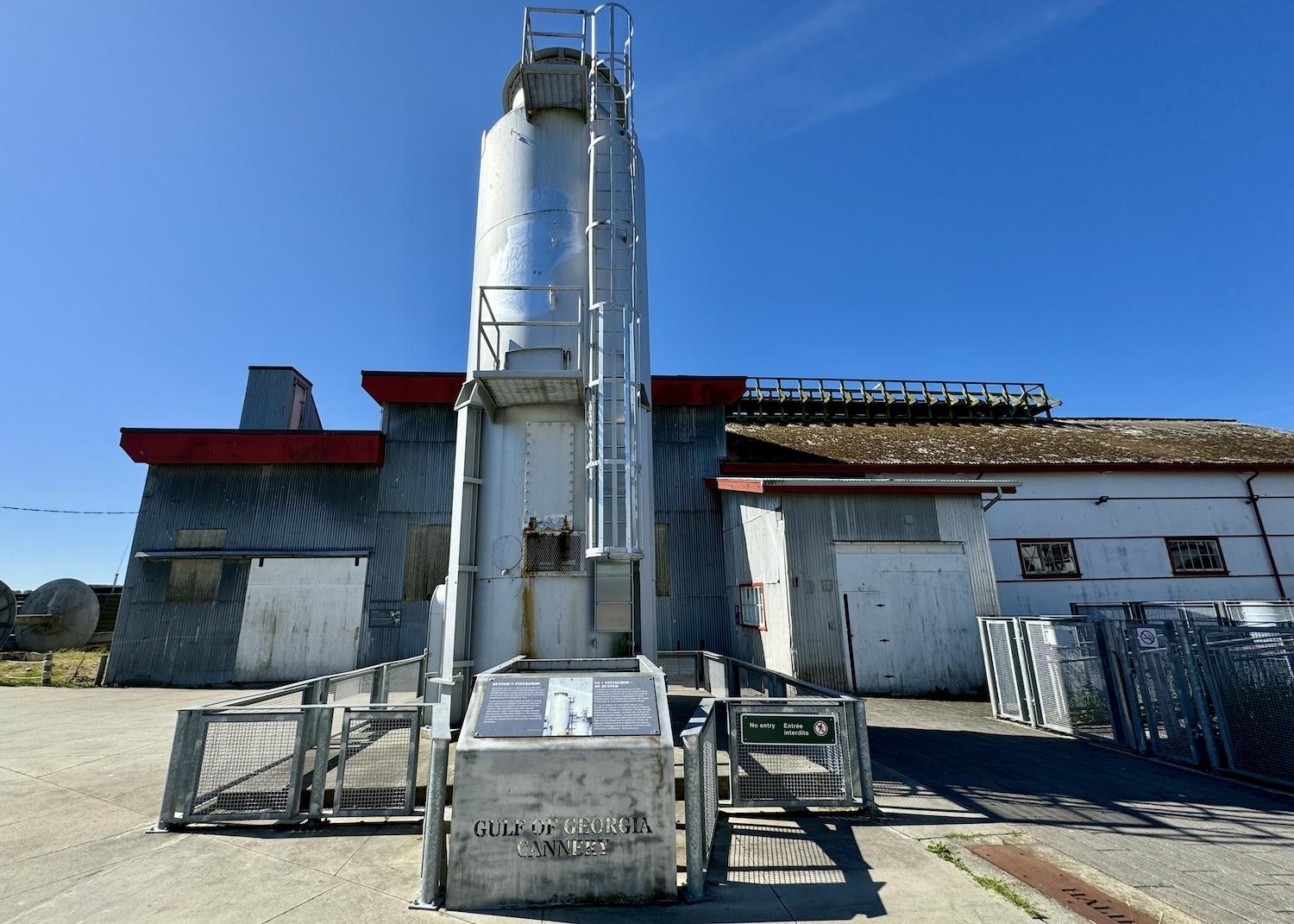
The cannery's herring reduction plant once made Steveston a notoriously smelly village. This Peabody Odour Control Unit, dubbed Buster's Stinkaroo, was erected to make things better but actually made the stench worse/Jennifer Bain
Now the Gulf of Georgia Cannery tells the overlapping and evolving stories of the First Nations who have fished the waters of the west coast since time immemorial, and the Chinese, Japanese and European people who arrived later to work in the fishing industry.
Three themed tours run daily from June 1 to September 1. You can also do-it-yourself by following the salmon from the net to can to plate, learning how canning lines and reduction plants work, and reading about the diverse cultures who once worked here and used “chinook jargon” to communicate.
First Nations people fished and worked in the pre-industrial era canneries. Chinese people, mainly men, worked in processing plants. The Japanese built boats, fished and did processing work. People of European origin worked in the fishing industry. Women from various cultural communities worked in this cannery, some replacing men during the two world wars.

On a "Machine Demo" tour, heritage interpreter Lucy Bosma details how salmon wind up canned. She even turns on several vintage machines/Jennifer Bain
You can step into the wheelhouse of a contemporary seine boat and check out a 3D fish wall. A Lego model of the complex, built by Peter Grant, is filled with fun nods to cannery history — even an iconic image of a worker lying on a mountain of salmon is recreated, complete with a photographer. A gift shop sells canned fish from an Indigenous-owned B.C. company.
On a sunny July weekend, as a bus load of young students from China visit, I make time for all three tours. After Lee’s “Cannery People” tour, I take the “Machine Demo” one with heritage interpreter Lucy Bosma. She shows us the jobs that had to be done by hand and the ones done by machines. She also lingers by the Iron Butcher, but for an entirely different reason.
“If you look up at this beam right above my head, there are still fish scales stuck to the ceiling from when this machine was still in operation,” Bosma points out. “So just a little taste of how messy it would have been to work the Iron Butcher back in the day.”

You can still see herring and salmon scales on the walls and ceiling of the Gulf of Georgia Cannery/Jennifer Bain
These particular messy bits are salmon. In another area of the cannery, there are herring scales on wood beams where a fish model hangs. “Look! The walls are covered in herring scales!” says a sign for those who don’t have a guide. “Look up … the ceiling is too!”
On the “Herring Reduction” tour, heritage interpreter Judy Caranto paints an evocative picture of just how much fish once swam in the waters outside. “If you just waited at the mouth of certain rivers, especially the mouth of the Fraser River, you could just hold your net out in the ocean and then have those fish come right into your nets. An old story goes that there was so much salmon that you could almost walk on the backs of them as they were swimming past.”
Canned salmon may seem like “a very simple item,” Caranto acknowledges, “but it’s a very large part of the history of Canada and the fishing industry.” This fish was preserved and shipped around the world in the time before refrigeration.
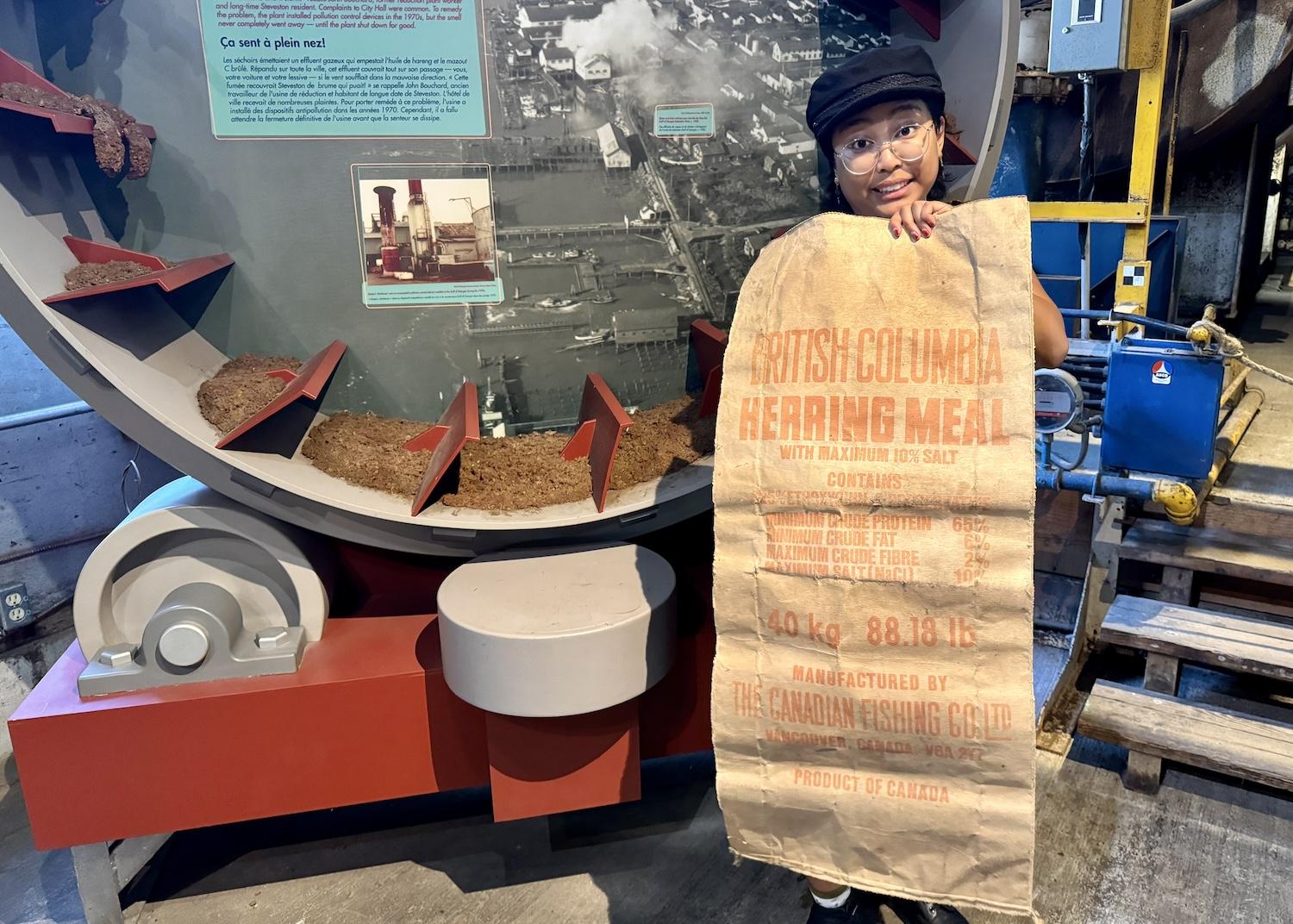
Heritage interpreter Judy Caranto shows how herring wound up becoming herring meal/Jennifer Bain
More stories about canned fish and fish as a food source — universal topics that everyone can relate to — are on tap. For now, an exhibit about “memories around the kitchen table” shows a plate of plastic sushi and photos of dried bulk seafood sold in Chinatown.
Visitors share their thoughts on a fish-shaped board, answering one of several pre-prepared questions.
“You DON’T like to eat a particular type of fish or seafood (or any at all). Share your story and tell us why,” the cannery asks.
“It is because I always gag when my tongue touches it,” one person replies in child-like printing.
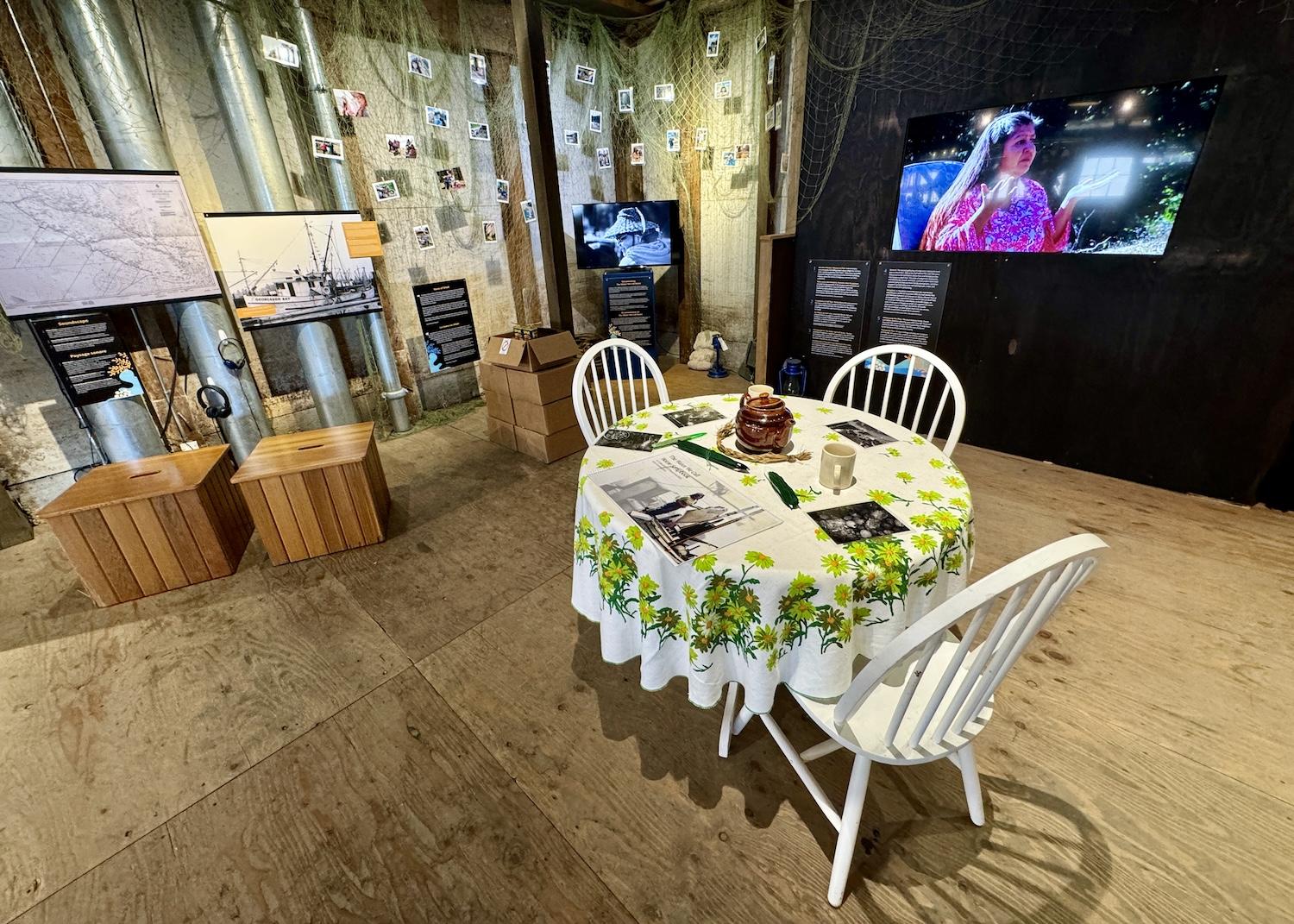
"The Water We Call Home" exhibit explores Indigenous women’s connections to fish, water and family around the Salish Sea. It includes an important story about SPAM/Jennifer Bain
Nearby, a temporary exhibit, “The Water We Call Home,” explores Indigenous women’s connections to fish, water and family around the Salish Sea. Led by Coast Salish/Sahtu Dene artist Rosemary Georgeson, this area is dominated by a cardboard box of SPAM.
“In various communities on the coast, priests were passing out cases of SPAM to houses on the rez as a way to stop people from being on the water, to further our disconnection from fish,” says Georgeson’s written statement. “It was one case per person per month for every person in the household. They didn’t show people how to open these cans, so they didn’t know what they were. No one had seen cans that needed keys, which were hidden under the wrapper.”
It was, the artist believes, “another sign of the beginning of the end of our fishing, our way of life and our way of being. It was all part of the attempt to keep us from fishing.”

In the early 1900s, small wooden commercial fishing boats held two men who did gillnet fishing/Jennifer Bain
A new management plan for the Gulf of Georgia Cannery — prepared in consultation with Indigenous peoples and the public — is nearing completion.
In the draft plan, Parks Canada says that “acknowledging the impact of colonialism on Indigenous peoples is a critical part of healing and a step toward reconciliation.” It pledges “to support Indigenous peoples in sharing their history and experiences, and to welcome more narratives, perspectives and voices to be heard.”
The impacts of climate change on the cannery’s old wooden buildings and cultural resources are a concern due to coastal erosion, rising sea levels and intensified weather events. Maintenance is another priority and having an unheated exhibit space can be a challenge at a site that’s open year-round.
An iconic photo of a man lying on a mountain of salmon is on the Gulf of Georgia Cannery wall next to an area that encourages visitors to take a closer look at decades-old fish scales/Jennifer Bain
While Parks Canada is responsible for major capital repairs, renovations and other conservation efforts, the society handles things like visitor services and programs.
Earlier this year, a modernized partnering and contribution agreement replaced a contract for services. Parks Canada gives the society $640,000 a year — about 50 to 55 per cent of what it needs — and the flexibility to make decisions and fundraise. The agreements speak to what the federal agency calls “the success of community-based cultural heritage stewardship.”
As my tour with Lee wraps up, she recalls a day in early June when she was leading visitors around the cannery while 28 people from 17 countries were becoming new Canadians in a citizenship ceremony in the boiler room-turned-theater.
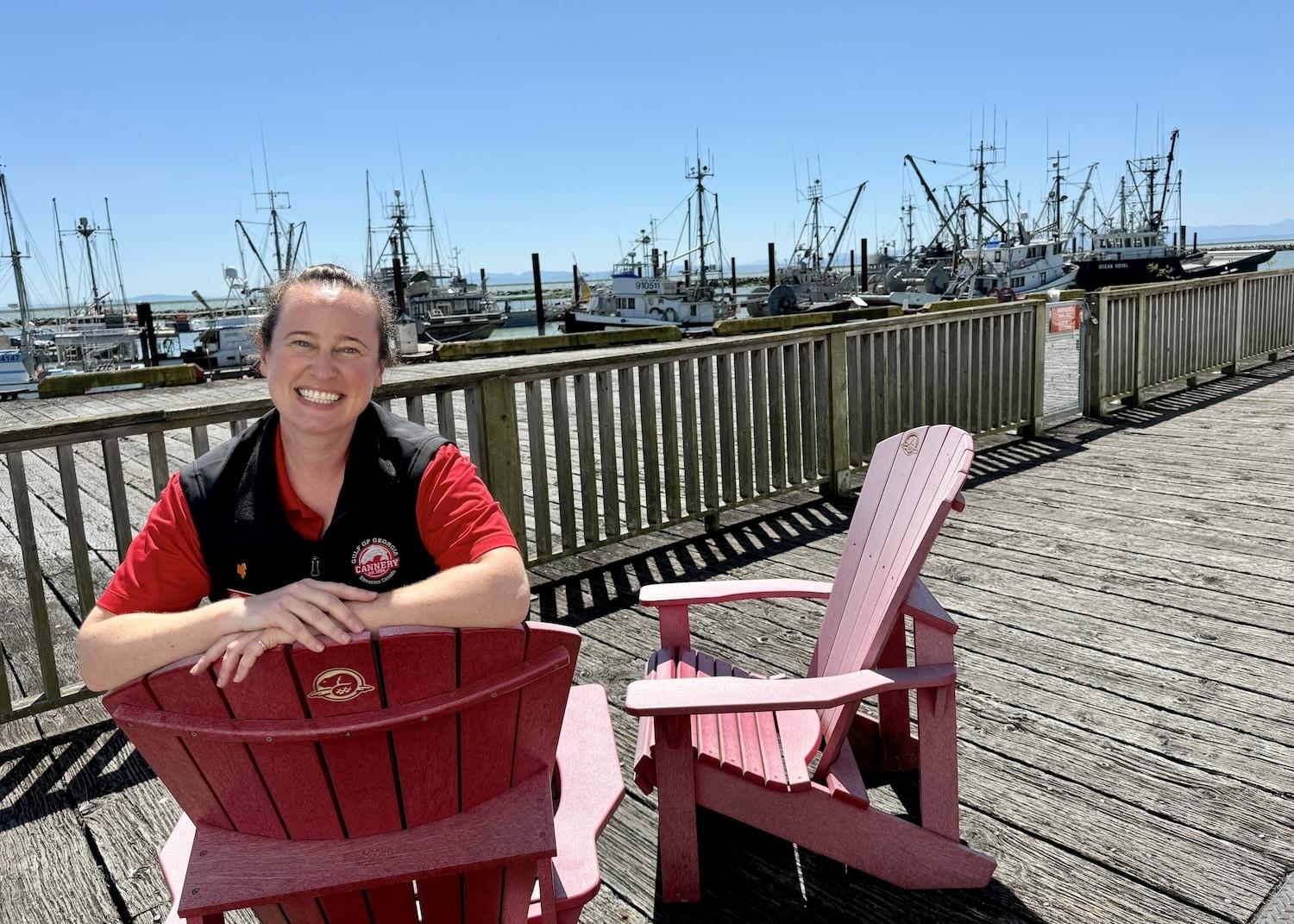
Gulf of Georgia Cannery's head interpreter Jamie Lee sits on Parks Canada signature red Adirondack chairs on a dock with views of Steveston's working fishing harbor/Jennifer Bain
“Obviously we’re not perfect now, but it made me really happy to think that in a building where many people had a really difficult start in this country, here we are getting to do something that’s a part of a lot of people’s brand-new journey,” Lee says.
It’s important to tell the stories of cannery people while acknowledging that “the contributions of some of these immigrant communities are not necessarily always recognized" as being part of the roots "of the west coast fishing industry, which really built the economy of British Columbia, but also established beautifully strong communities that are still existing here.”
As we end the frank and enlightening tour, a couple from nearby Vancouver Island puts it best when they tell Lee: “This is a lot of stuff — a lot to reflect on actually.”
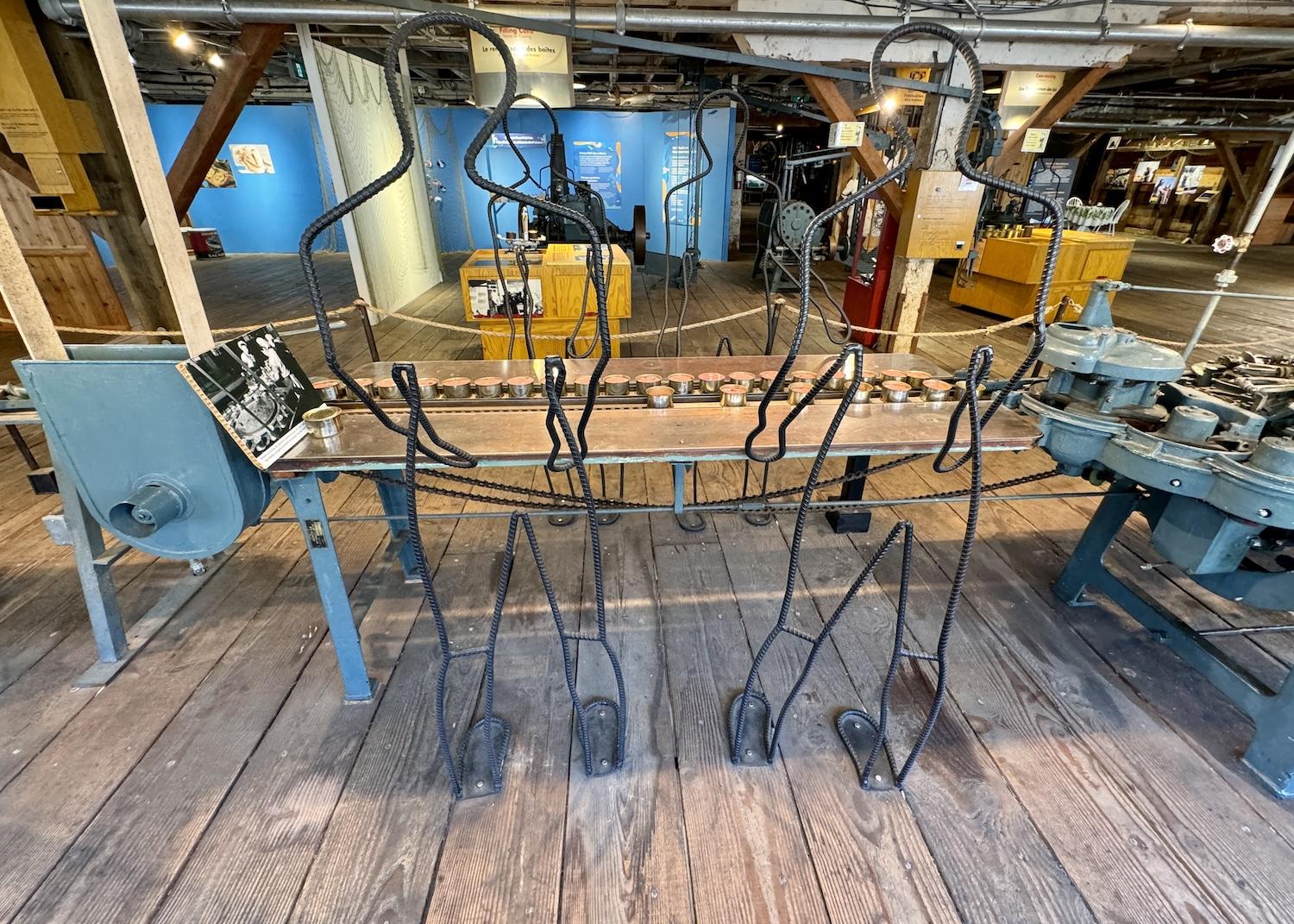
Metal silhouettes can be found along the salmon cannery line at the Gulf of Georgia Cannery National Historic Site to help visitors visualize all the people who once worked here/Jennifer Bain



 Support Essential Coverage of Essential Places
Support Essential Coverage of Essential Places






